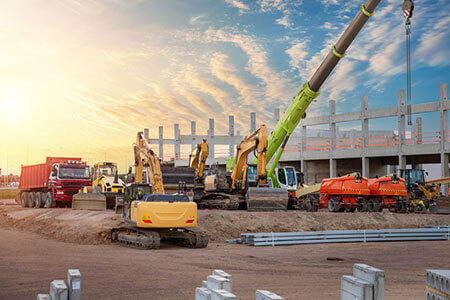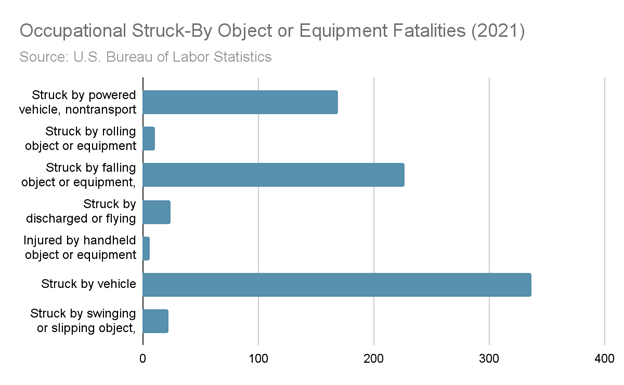Struck-By Accidents

Struck-by accidents are a tragically common occurrence in the workplace. Swinging, falling, flying, and rolling objects pose a serious danger to those working on construction sites.
Despite their frequency and severity, accidents such as these are often hard to distinguish from caught-in/between accidents. Caught-in/between accidents can resemble struck-by accidents because those involved in caught-in/between accidents are often struck by an object.
The primary distinction between these two types of accidents is what aspect of the accident caused the injury: impact or construction. In a struck-by accident, injury is caused by the impact of an object alone.
TABLE OF CONTENTS
- Common Injuries from Struck-By Accidents
- The Dangers of Struck-By Accidents
- Types of Struck-By Accidents
- Struck-By Accident Hazards and Prevention
- New York Labor Law 240(1) and Struck-By Accidents
- Case Study: $4.75 Million for Laborer Struck by Flying Rock
- What to Do After a Struck-By Accident
- Legal Help for Struck-By Accidents
Common Injuries from Struck-By Accidents
Struck-by accidents are tragically dangerous, often leaving victims with damages that they are not prepared for. One moment, you are working as usual; the next, a massive load of materials is swinging right at you. Harm is inflicted upon victims by the sheer force of flying, rolling, swinging, and falling objects. As you can imagine an impact like that can wreak havoc on the body.
Common injuries in struck-by accidents include:
- Bone fractures
- Soft tissue damage
- Anxiety
- Traumatic brain injury
- Full or partial paralysis
- Depression
- Herniated or bulging discs
- Loss of limbs
- Post-traumatic stress
- Death
Unfortunately, this is not an exhaustive list of all the harm that an accident can cause. Damages can range anywhere from lost wages, career loss, medical bills, strained relationships, and much more.
The Dangers of Struck-By Accidents
Struck-by accidents are one of the most common and dangerous construction site accidents and are included in the Occupation Safety and Health Administration’s “Fatal Four:” falls, caught-in/between, electrocution, and, of course, struck-by accidents. For construction workers, fatalities from struck-by accidents are twice as likely than in any other profession.
Struck-by accidents are the second-most common cause of death for construction workers, only surpassed by falls. Unfortunately, struck-by accidents are not just a threat to construction workers. In 2021, struck-by accidents took the lives of 473 workers from all industries.
Types of Struck-By Accidents
The term “struck-by accident” covers a wide range of incidents, which can make them difficult to identify and distinguish. As mentioned above, struck-by accidents are produced by forcible impact, which then injures the victim. There are four ways that forcible impact is produced in accidents such as these:
Struck-by falling object: It can be challenging to discern struck-by falling object incidents from caught-in/between accidents. This is because many falling objects, including collapsing material, can crush or suffocate a victim. The most important distinction between these two categories of accident is in the case of a struck-by falling object accident, the sheer impact of the falling object would be the cause of injury. Struck-by falling object accidents typically occur when items are improperly secured, such as loose cargo or flyaway tools.
Struck-by flying object: Struck-by accidents caused by flying objects occur when an item has been propelled across space. This could potentially be caused by compressed air, separated material from equipment, or a projectile object shot from a power tool, such as a nail gun. Any injuries resulting from an object being flung or thrown would be considered the result of a struck-by flying object accident.
Struck-by swinging object: The most common contributor to struck-by swinging object accidents is swinging loads that have been mechanically lifted. Once lifted into the air, loads can suddenly begin to swing or twist. This is exacerbated by high winds. Swinging materials can swoop into an unexpected area, seriously injuring workers or pedestrians. This type of accident is often found in cases involving cranes.
Struck-by rolling object: Struck-by rolling object accidents are the most familiar accident to the average person. These accidents occur when an object is moving on the same level as bystanders; this includes any rolling or sliding objects or vehicles. Any instance in which a vehicle strikes someone is categorized as a struck-by rolling object accident, unless the victim is caught underneath the car, making it one of the most common struck-by accidents.
Struck-By Accident Hazards and Prevention
Hazards exist everywhere on the job site and beyond, but it is imperative that we identify them and take the proper precautions. The Occupational Safety and Hazard Administration (OSHA) has identified the following common struck-by accident hazards:
- Compressed air
- Objects ejected under power by a tool, particularly if fired from a powder-actuated tool
- Thrown, hurled, or otherwise propelled objects
- Poorly stored/secured loose materials
- Heavy objects stored at a height
- Lack of personal protective equipment
- Windy conditions
- Mechanically lifted materials
- Improperly rigged loads
- Working under suspended loads
- Poor communication between workers and those operating heavy machinery
- Rolling, moving, or sliding objects on the same level at which people are located
- Motor vehicles, especially heavy construction vehicles, that are operated near bystanders
Being struck by an object happens in the blink of an eye. Little can be done once an object is in motion, so the best way to prevent injury is to prevent dangerous moving objects in the first place. The Occupational Safety and Hazard Administration (OSHA) outlines a variety of ways that employers and their employees can prevent workplace struck-by accidents. These precautions include, but are not limited to:
- Never cross the path of a backing vehicle
- Only drive vehicles in reverse gear when your rear view is unobstructed
- Do not use tools with cracked or loose handles
- Inspect and maintain all machinery
- Engage parking brake when vehicles are parked and chock wheels when on an incline
- Employ the use of barricades, flaggers, or traffic signs if working near a public road
- Wear bright or reflective clothing that is obviously visible in any lighting
- Always make eye contact with the operator before approaching a vehicle or other piece of heavy machinery
- Secure all tools and other loose materials when working at an elevation
- Ensure that all equipment operators are trained and licensed to operate tools, equipment, and vehicles necessary
- Keep work areas clear
- Secure materials against wind gust
New York Labor Law 240(1) and Struck-By Accidents
In the context of construction in the State of New York, laws exist to provide protection to workers from the risk of being struck by objects. Specifically, New York State Labor Law 240(1) provides that contractors and owners, “shall furnish or erect, or cause to be furnished or erected for the performance of such labor, scaffolding, hoists, stays, ladders, slings, hangers, blocks, pulleys, braces, irons, ropes and other devices which shall be so constructed, placed and operated as to give proper protection to a person so employed.”
The policy considerations behind Labor Law 240(1) put the responsibility on those in a position to make sure safety precautions are taken and regulations are adhered to, namely property owners and general contractors. As such, if a worker on a construction project is injured as a result of being struck by an object, and the owner or contractor fails to provide protection to the worker, then the owner, and contractor will be held responsible for the accident.
To evaluate whether a Labor Law 240(1) violation has occurred, you need an attorney with extensive experience in the evaluation of complex legal issues. This requires obtaining information regarding how the accident occurred, what safety devices were or were not provided to the worker, whether safety devices provided by the owner and contractor were the appropriate safety devices and whether such devices were properly used by the worker and whether the worker followed explicit instructions provided with respect to the use of safety devices.
Such evidence is obtained by reviewing safety protocols and procedures implemented at the worksite, obtaining photographs and videotapes from the workplace, evaluating accident reports prepared contemporaneous with the happening of the accident, interviewing witnesses, and taking sworn testimony from supervisors of the contractors on site, as well as safety personnel.
Owner and contractor liability for a violation of Labor Law 240(1) is frequently decided by the Court in a Motion of Summary Judgment. These motions seek a judicial determination by the Court as to whether the owner and contractor have violated Labor Law 240(1). The attorneys at Block O’Toole & Murphy have extensive experience in identifying cases of falling objects that involve a violation of Labor Law 240(1), in gathering the evidence that is vital to proving such a violation and in performing the legal research and writing to convince the Court to hold contractors and owners responsible for such violations.
Case Study: $4.75 Million for Laborer Struck by Flying Rock
In the Bronx, a 46-year-old foreman was working on a job site that required blast operations. The worker lacked any form of blasting experience, including training or education regarding the practice of blasting. With no designated “safe” areas in sight, the foreman stood approximately 90 feet below the blast site, unaware of how far he should be from the blast. His co-worker, overseeing the blasting, sounded the horn, signaling the blasting’s commencement. The horn prompted the foreman and another worker to move to what they assumed to be a safe area, but they were wrong.
The foreman was suddenly caught in a rain of debris that he could only compare to a meteor shower. As he was attempting to flee the wreckage, he was struck by a football-sized boulder in the lower back. As a result, he experienced an array of fractures, several bulging discs, and multiple tears in his shoulders. He suffered intense psychological distress, resulting in a diagnosis of post-traumatic stress disorder and adjustment disorder.
Our firm attorneys, Daniel P. O’Toole, and Frederick C. Aranki contended that our client was wrongfully injured because the blaster failed to direct our client to a safe area. It was determined to be the blaster’s responsibility to guarantee that everyone on the site was at a safe distance. Our client was awarded $4,750,000 to compensate him for his injuries and damages.
What to Do After a Struck-By Accident
Following a struck-by accident, you should make sure that any danger has passed before moving to a safer area. Although emergency situations can be chaotic and stressful, it is important that you seek medical attention if you have been injured. Even if you do not believe you have experienced a significant injury, there may be injuries that you are not yet aware of. Be sure to accept any treatment and imaging suggested by medical professionals.
- File a Police Report: Provide a full, comprehensive account of the accident to law enforcement, who will show up on the scene if emergency services have been called. Any other parties, including witnesses, should also provide their account of the incident.
- Report the Accident to Your Employer: OSHA requires employers to report accidents, even if it is a small company that is not required to keep routine OSHA records. Report the accident to your immediate supervisor as soon as possible.
- Seek Legal Counsel: If you have been wrongfully injured in a struck-by accident, you may be entitled to financial compensation. Contact a personal injury attorney as soon as possible; an experienced lawyer can provide you with the knowledge, guidance, and expertise that you will need to recover financially.
Legal Help for Struck-By Accidents
If you or a loved one have experienced injury due to being struck by an object, you deserve full and fair compensation under the law. While compensation does not solve everything, it can relieve you of financial burdens so that you can focus on what matters most. Having an experienced attorney on your side can provide you with the level of expertise and knowledge that you will need to hold the negligent party accountable. The attorneys at Block O’Toole & Murphy have a proven record of accomplishment in recovering compensation for clients injured in struck-by accidents.
Select recoveries involving struck-by and falling object accidents include:
- $110,174,972 jury verdict for a cyclist whose thoracic spine was destroyed when a railroad fell on him from subway tracks above
- $15,000,000 settlement for the surviving family of a worker who died when crushed by a commercial air chiller
- $9,000,000 settlement for a 14-year-old boy injured by a collapsing wall in a shopping center parking lot
- $7,000,000 settlement for a carpenter who was struck in the face by a metal clamp while dismantling scaffolding
- $5,500,000 settlement for a truck driver who was struck by the metal gate of a freight elevator
- $3,500,000 settlement for pedestrian injured by a piece of limestone that had fallen from a tenth-story apartment
To schedule a free consultation, fill out our online contact form or call 212-736-5300. Our firm serves New York and New Jersey.


